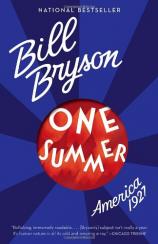One Summer: America, 1927
Review
One Summer: America, 1927
Someday, somebody is going to write a history of the year 2013, and it is going to be just so embarrassing. I probably won’t be around to read it, but just imagine what somebody born in 2037 is going to think of us poor schlubs stuck in 2013, with our primitive smartphones, non-flyable cars, and endless, grinding commercialism. I figure the future history books are going to look back on this year with the same sort of mockery and contempt that we reserve for the polyester fashions and unappealing music of, say, 1977. There’s going to be a whole chapter in the book on Miley Cyrus and what twerking was, and I am just sick thinking about it.
To his credit, Bill Bryson doesn’t engage in a lot of mean-spirited mockery about 1927 in his new book. ONE SUMMER focuses primarily on the prominent Americans of that time and their experiences from that summer, most of whom (with the notable exception of Henry Ford) come off looking much better than the celebrities of our time do now. To be sure, 1927 was full of all sorts of ridiculous (not to mention dangerous) nonsense, but Bryson looks back on it with clear eyes, not impeded by nostalgia or hero-worship, trying to tell the important stories of the people who others looked up to.
ONE SUMMER is dominated by the figure of Charles Lindbergh, who famously flew The Spirit of St. Louis across the Atlantic Ocean and landed in Paris as the most famous man in the world. Aviation is a dominant theme here, but as Bryson points out, that’s what people were interested in; the New York Times ran aviation stories on its front page for weeks after the Lindbergh flight. Lindbergh appears to have been the only man skilled enough at the time to have made the flight --- Bryson delights in pointing out the shortcomings of the other pilots vying to cross the Atlantic at the same time --- but piloting an airplane is a vastly different thing than dealing with the literal crush of the public trying to get their hands on you and your airplane. Although Lindbergh took off on a coast-to-coast barnstorming tour of America after his heroic flight, he appears to have been totally exasperated with the public relations side of things.
"The best way to enjoy the book is to just let it all wash over you, to let Bryson’s masterful narrative voice tell you the stories, one after the other, sometimes stacked one on top of another, sometimes jostling for space like impatient passengers trying to board a train."
This also seems to have been true of Calvin Coolidge, who spent the summer of 1927 camped out in South Dakota, from which he transmitted a characteristically terse message indicating that he would not run for re-election in 1928, and said all of five words at the following press conference. But it was emphatically not true of Babe Ruth, who led the “Murderer’s Row” of the 1927 Yankees, who swept through the American League like a harvester in a cornfield. And it was also not true of the guy who sat on a pole in Newark for the better part of the month, or any other thrill-seeker or attention-getter from the time that you can think of, or even those you never heard of.
Suffice it to say that there was a whole lot going on in 1927. Bryson thinks you should know about it, and is willing to tell you if you just sit back and listen. The best way to enjoy the book is to just let it all wash over you, to let Bryson’s masterful narrative voice tell you the stories, one after the other, sometimes stacked one on top of another, sometimes jostling for space like impatient passengers trying to board a train. There are so many stories to tell, and there is at least a temporal connection between them. Anyway, you’re not doing anything else, so just sit down and let Bryson tell you about Herbert Hoover and what he was up to.
ONE SUMMER works very well on a narrative level, but not so much as a book of history. Bryson has a very loose framework for the tale, which means that he goes back and forth between different stories, without much in the way of a discernible pattern. (The reader is often introduced to a character or a theme, and then Bryson explains that he’ll get to whoever it is later.) When Bryson fixates on a theme, though, he piles on every bit of relevant backstory that he can find --- including the tidbit that Charles Lindbergh’s father had a slightly different middle name than he did. This is fine storytelling, but it makes the book seem unfocused and wandering at times. However, the real problem with the book is that Bryson isn’t adding anything to the story of 1927 except his own voice and talents. There’s no room in his breezy, airy style for analysis or even original thought.
If you are looking for an omnibus look at 1927, ONE SUMMER is not a bad place to start; it’s wholly entertaining and occasionally delightful. However, all that reading it did for me was cause me to look at other books in my library that cover the same time frame --- particularly the wonderful LAST CALL, Daniel Okrent’s history of Prohibition, and RISING TIDE by John Barry, about the disastrous Mississippi River flood of that year. ONE SUMMER is a good starting point for anyone looking into the 1920s, but there are many more comprehensive works out there for the serious reader.
Reviewed by Curtis Edmonds on October 25, 2013
One Summer: America, 1927
- Publication Date: June 3, 2014
- Genres: History, Nonfiction
- Paperback: 544 pages
- Publisher: Anchor
- ISBN-10: 0767919416
- ISBN-13: 9780767919418





